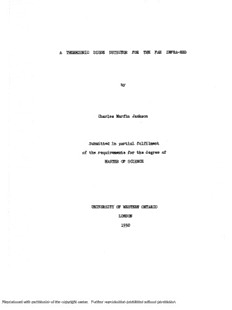
A thermionic diode detector for the far infra-red PDF
Preview A thermionic diode detector for the far infra-red
A THERMIONIC DIODE DETECTOR FOR THE FAR INFRA-RED by Charles Murfin Jackson Submitted in partial fulfilment of the requirements for the degree of MASTER OF SCIENCE UNIVERSITY OF WESTERN ONTARIO LONDON 1950 Reproduced with permission of the copyright owner. Further reproduction prohibited without permission. UMI Number: EC54044 INFORMATION TO USERS The quality of this reproduction is dependent upon the quality of the copy submitted. Broken or indistinct print, colored or poor quality illustrations and photographs, print bleed-through, substandard margins, and improper alignment can adversely affect reproduction. In the unlikely event that the author did not send a complete manuscript and there are missing pages, these will be noted. Also, if unauthorized copyright material had to be removed, a note will indicate the deletion. ® UMI UMI Microform EC54044 Copyright 2009 by ProQuest LLC. All rights reserved. This microform edition is protected against unauthorized copying under Title 17, United States Code. ProQuest LLC 789 E. Eisenhower Parkway PO Box 1346 Ann Arbor, Ml 48106-1346 Reproduced with permission of the copyright owner. Further reproduction prohibited without permission. -ii- Approved for the Department of Physics Reproduced with permission of the copyright owner. Further reproduction prohibited without permission. = lil- This research was made possible by the financial assistance of the Department of Veterans1 Affairs and a bursary from the National Research Council. The writer wishes to thank these organizations for their aid. Reproduced with permission of the copyright owner. Further reproduction prohibited without permission. -iv- ACKNOWLEDGMENTS I wish to express my appreciation to Dr. R. C. Dearie, F.R.S.G., ray research professor, for his guidance and co-operation, and to Dr. A. D. Misener, Head of the Physics Department, for use of departmental facilities. My sincere thanks to the staff of the Physics Department for their helpful suggestions. I am indebted to Dr. K. V. Hunten for his super vision during the construction of the evacuation system by Mr. Turner, Mr. Searle and myself. Reproduced with permission of the copyright owner. Further reproduction prohibited without permission. CONTENTS Page Acknowledgment s ........................................................................ iv Tables .......................................................................................... vi Illustrations ........................................................................... vii Abstract ................................................................... v iii Suramary ................ ix Introduction ................................................................ 1 Chapter I - Theoretical Minimum Detectable Power of a Thermionic Diode ......... 4 Chapter I I - Construction of Diodes................... 11 Chapter III - Evacuation and Sealing off of the Diodes ...................................... 17 Chapter 17 - ft Continuously Evacuated Diode ............. 20 Chapter V - Sources of Infra-red Energy and Energy Filters ............................ 28 Appendix I - (l) Relation between plate current and galvanometer current ........... 30 (2) Detection in Changes of Filament Supply Voltage ............................... 31 Appendix II - Richardson's Equation ............................ 33 Appendix III - Evacuation Systems and Equipment .... 37 Appendix 17 - Infra-red Windows and Getters ....... 4& Bibliography................................................................................ t& Reproduced with permission of the copyright owner. Further reproduction prohibited without permission. -*vi™ TABLES Page Diode Characteristics ...................................., ............................ 21 Reproduced with permission of the copyright owner. Further reproduction prohibited without permission. -v ii- ILLUSTRATIONS Page Figure 1. Sensitivities of Detectors ............. v iii Figure 2, Radiation Spectra ..................................................... 3 Figure 3. Atmospheric Absorption .............................. 3 Figure 4. Diode Sensitivity Curve ............. 10 Figure 5. Diode Infra-red Detector ................. 12 Figure 6. Tubes Constructed ............. 13 Figure 7. Sealing-off Equipment .............. 14 Figure 8. Continuously Evacuated Diode ........................................ 15 Figure 9. Evacuation of Diode ................... 18 Figure 10. Characteristic Curves of Diode .................................... 21 Figure 11. Curve of Power Detectable with Tungsten................... 22 Figure 12. Circuit of Diode ............ 25 Figure 13. Layout of Equipment .......................... 27 Figure 14. Energy Distribution of Hernst Glower................. 28 Figure 15. Sniperscope Window ................ 29 Figure 16, Evacuation of Diode ........... 37 Figure 17. Detection of Leaks ............... 41 Figure 18. Ionization Gauge ................ 41 Figure 19. McLeod Gauge ........... 43 Figure 20. Heating Oven .......................................................................... 44 Figure 21. Regulated Power Supply .............. 45 Figure 22, Trahemission of KC1 and KBr Crystals ...................... 46 Reproduced with permission of the copyright owner. Further reproduction prohibited without permission. ABSTRACT In recent years, there has been an increasing interest shown in receivers for infra-red detection. In 1939, E. D. Wilson patented a receiver by which infra-red energy is detected as a change in satur ation plate current of a diode. If a diode cathode, from which saturation plate current is drawn, is subjected to infra-red energy, its temperature is raised and the plate current increases according 5 — h. to Richardson*s Equation, I - AT e T Theoretical considerations Indicate that a diode, using a Cs-CsO-Ag cathode surface, has a maximum sensitivity of 2.34 x 10"^ watts per unit bandwidth^. This value is comparable to the sensi tivities of known infra-red detectors (see Fig. l). This fact, coupled with the diode*s ruggedness and mobility, justifies an inves tigation of its properties, when used as an infra-red detector. Experimental work carried out on a diode using a tungsten wire emitter led to the conclusion that a diode from which saturation cur rent was being drawn could be used to detect radiant energy. Reproduced with permission of the copyright owner. Further reproduction prohibited without permission. THERMOCOUPLE OR BOLOMETER P k -5---------------- PHOTOCONPUCTJVE CELL TIME CONSTANT »2i-\5EC0NOS AARREEAA — I MM Cs~0----- PHOTOCELL S T T Cs-Sto------ A photomultipler W ONE PHOTON x $r \ each \ SECONDS H (r RADIO /A PRESENT ATTAINABLE THRESHOLD FOR DETECTION OF ELECTROMAGNETIC RADIATION AS A FUNCTION OF WAVELENGTH. BLACK-BODY EMISSION AT 300* K IS ALSO SHOWN. Figure 1 Reproduced with permission of the copyright owner. Further reproduction prohibited without permission.
